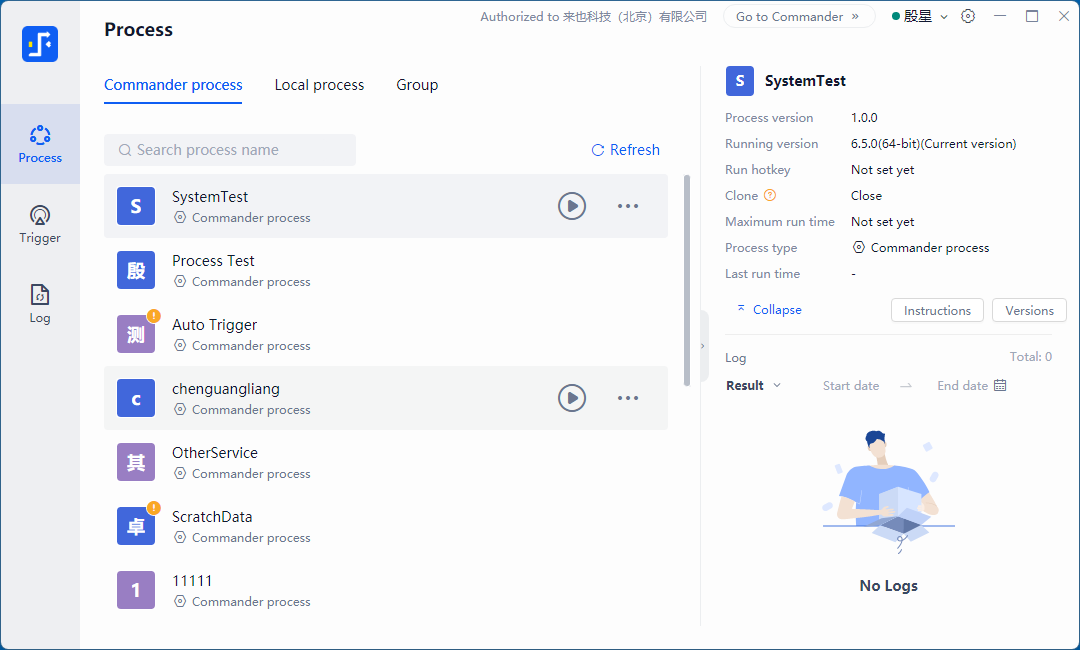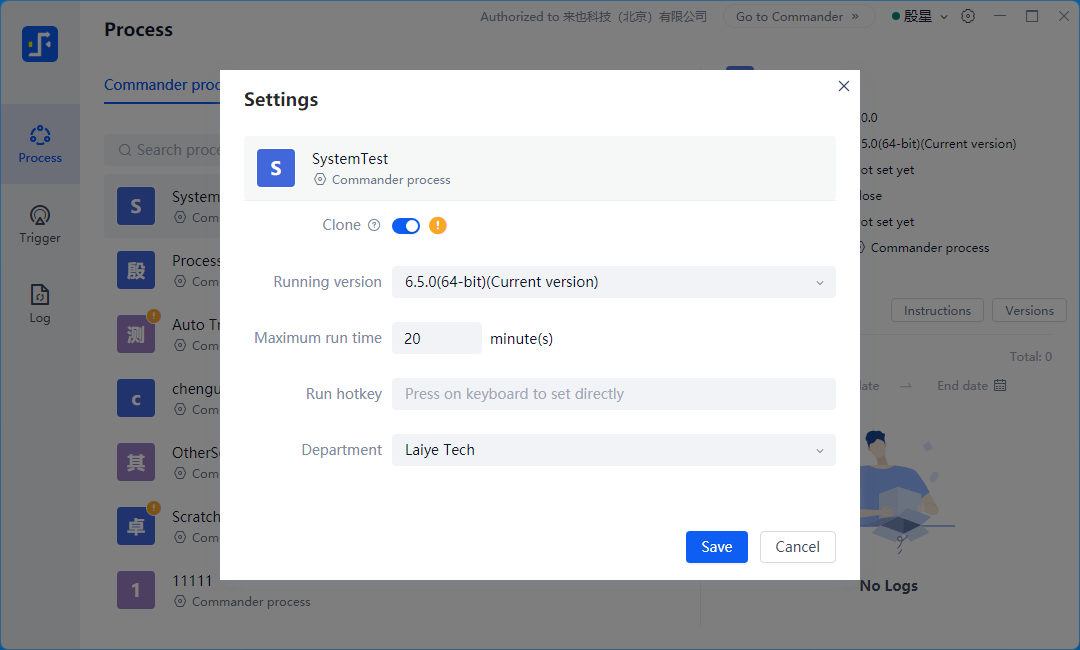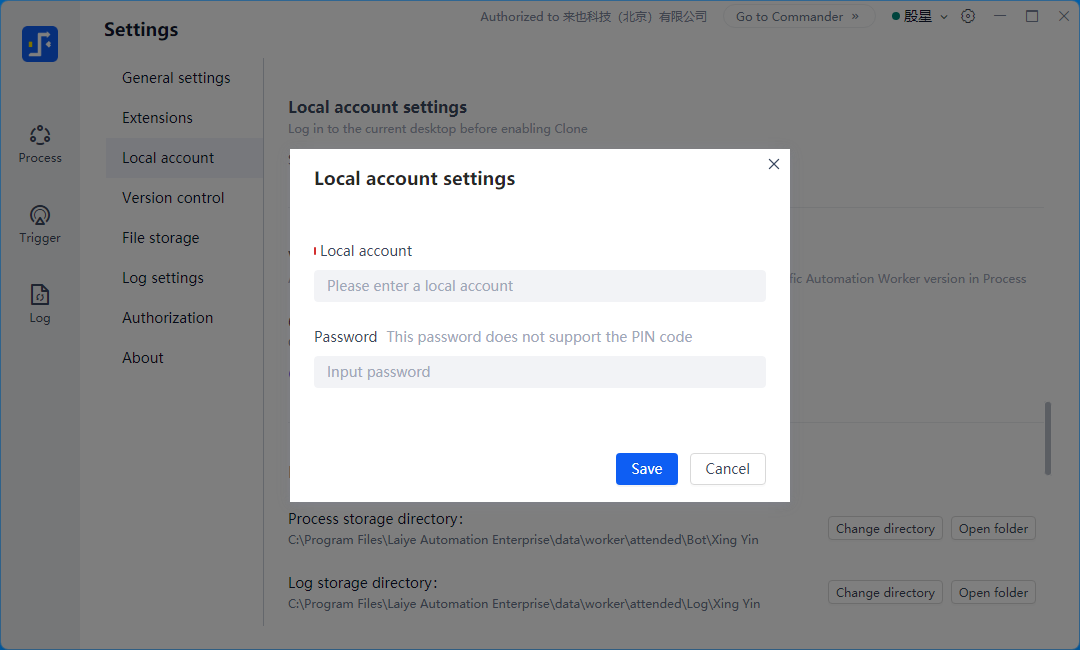Automation Commander Process
Due to the design of the "Attended-Node-locked License" and the "Attended-Floating License," the functionality interface differs depending on the license type after entering the home page. Under the left-side menu "Process," the differences between the two licenses are as follows:
- "Attended-Node-locked License": Local Process, Group
- "Attended-Floating License": Automation Commander Process, Local Process, Group
Note: There are differences in the functionality within the Group. See details below.
Automation Commander Process
This is only available under the "Attended-Floating License."
Process List
The Automation Commander Process list does not require manual addition. Attended-Floating License Automation Worker can directly access the online processes of Automation Commander. Users can also manually refresh the process list.

The list displays information (icons, process names, types) and operational buttons (Quick Run, Run, Continuous Run, Run Settings, Process Input Settings). It also supports fuzzy search by inputting the process name.

Note: If the selected process does not contain "Process Input," the "Process Input Settings" menu will not be displayed.
Important Notes:
- The current user can only access the online processes of Automation Commander that their department has permissions for.
- If there are updates to the online processes in Automation Commander, the Automation Commander Process on Automation Worker will automatically update.
Running a Process
You can click the "Run" button to directly execute the selected process.
During execution, Automation Worker will minimize by default. When the window is forced into focus, the top of the home page will display "Running: xxxxxxx," and the "Run" button will switch to a "Stop" button. Clicking it will stop the execution, and the result is typically marked as "Failed."
When a process is running, you can forcibly terminate it by holding Ctrl+F12.
Important Notes:
If you use a new version of Automation Worker to run an older version of a process file, you may receive a system prompt as shown below. If execution fails or does not meet expectations, you can set the corresponding version of Automation Worker to better support historical versions of .bot files or update the process using a new version of Automation Creator.
If your process includes "message dialog" settings during development, the process will display corresponding message content and buttons during execution. You may need to click "OK" to proceed or end the process.
If other situations occur, follow the page prompts for guidance.
If the process has issues, contact technical personnel to debug and troubleshoot the process using Automation Creator.
Single Run
To the right of the selected process, click the "..." icon to open a menu panel with four options: Run, Continuous Run, Run Settings, and Process Input Settings.
Selecting "Run" has the same effect as directly clicking the "Run" icon, which performs a single run.
Continuous Run
When selecting "Continuous Run," a popup provides two options: (1) Specify the number of runs; (2) Specify the time duration.
Continuous Run also allows setting whether to terminate the process after a failed run.
Examples are as follows:

Run Settings
Run settings include configurations for "Clone Run," "Run Version," "Maximum Runtime," "Run Hotkey," and "Department."

Clone Run
Each process and Group can individually enable or disable Clone Run in "Run Settings." A process with Clone Run enabled will execute in the Clone environment on the current Windows desktop.
Preconditions:
- Install the CloneExtension plugin through the settings.
- Configure account and password under "Settings - Local Account."
Features of Clone Run:
- The Clone environment operates independently from the original desktop environment. Users can continue to use applications on the original desktop during Clone execution.
- The Clone Run window displays the real-time execution screen of the process.
- Users can choose whether to control or pin the Clone window. If control is enabled, users can interact with the Clone desktop using the mouse.
When a process or Group is set to Clone Run, clicking "Run" or "Continuous Run" will open a Clone desktop window. Before execution, you need to log into the current Windows user account. You can also pre-configure a local Windows user account in settings. If not configured, a local account setup prompt will appear, as shown below:

After entering the Windows user account password, the process will run in the Clone desktop environment.
Run Version
Supports selecting a specific version to run the current process, typically an older version installed locally. Dropdown options can be added through "Settings - Version Management."
Maximum Runtime
Controls the maximum runtime for the process. If exceeded, the process execution will be forcibly terminated.
Hotkey Run
Processes or Groups can have hotkeys configured in "Run Settings" to trigger execution via keyboard shortcuts.
Department
Only available under the "Attended-Floating License." It records the department to which the process execution belongs. When associated with multiple departments, a dropdown selection is available. Execution details for different departments can be viewed in Automation Commander.
Process Input Settings
Process input settings allow personalized assignment of input variables before execution to meet specific business needs.
Process input variables include three parts: variable type, variable name, and variable value.
Variable types include text, number, boolean, and credential, designed through Automation Creator.
Select a process, click the "..." icon, and in the menu, click "Process Input Settings."
Note: If the selected process does not have "Process Input," the "Process Input Settings" menu will not appear.
Process Details
Select any process from the Automation Commander Process list to view more detailed information in the process details section on the right (as shown below):
- Basic information: process name, version, last execution time, process type, etc.
- Configuration information: run version, hotkey, maximum runtime, Clone Run toggle, etc.
- Operation buttons: user guide, version notes, etc.
- Logs.
View User Guide
Click the "User Guide" button to view the user guide written during process publishing via Automation Creator. If no content is displayed, the publisher did not provide a user guide. This functionality is not available for Groups.
View Version Notes
Click the "Version Notes" button to view the version notes written during process publishing via Automation Creator. If no content is displayed, the publisher did not provide version notes. This functionality is not available for Groups.
View Logs
For processes, logs include records and results of each execution.
For Groups, logs include records and results of each subprocess execution.
Query Logs
Logs can be queried by execution results or date range.
Execution results include four types: success, failure, stop, and cancel.
The date range, as shown below, supports quick selections like "Today," "Yesterday," "Past 7 Days," "Last Month," or custom date ranges.
View Execution Logs
Logs in the process details section support viewing execution logs through a popup window.
View Screen Recording
Logs in the process details section support viewing screen recordings through a popup window.